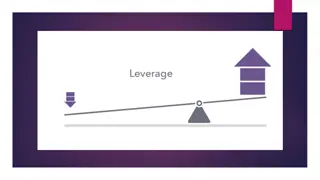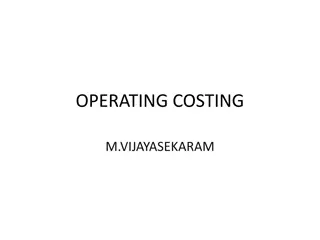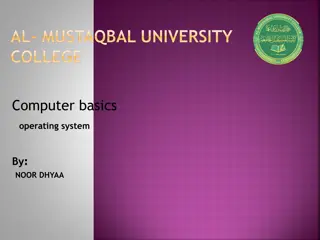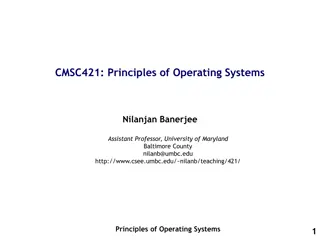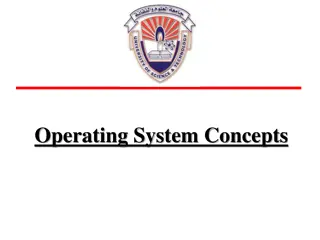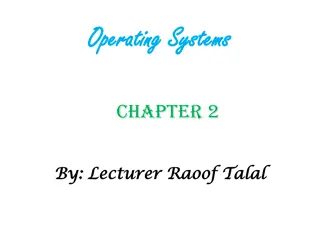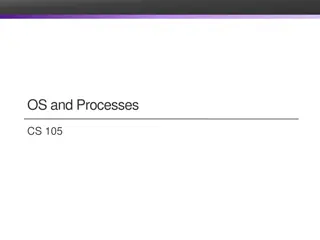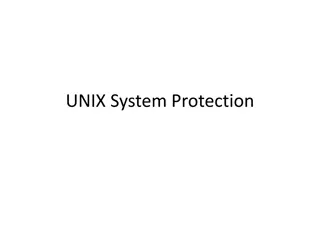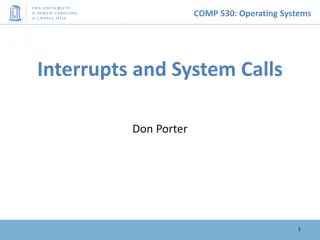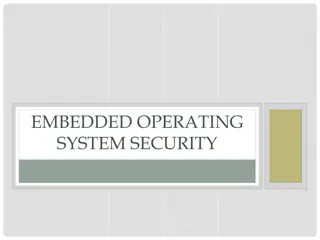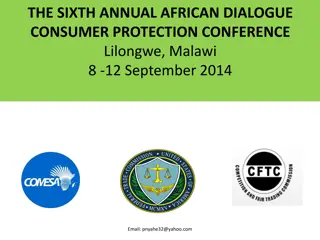Understanding Operating System Protection Principles
Explore the goals, principles, and implementation of protection in computer systems, including access matrix, domain structure, and capability-based systems. Learn how protection domains and access control are used to specify resource access, and delve into the concept of least privilege and dynamic domain switching. Gain insights into domain implementation in UNIX systems, focusing on user-id domains and domain switching mechanisms like setuid, su, and sudo commands.
Download Presentation

Please find below an Image/Link to download the presentation.
The content on the website is provided AS IS for your information and personal use only. It may not be sold, licensed, or shared on other websites without obtaining consent from the author. Download presentation by click this link. If you encounter any issues during the download, it is possible that the publisher has removed the file from their server.
E N D
Presentation Transcript
CSE 30341 Operating System Principles Protection
Overview Goals of Protection Principles of Protection Domain of Protection Access Matrix Implementation of Access Matrix Access Control Revocation of Access Rights Capability-Based Systems Language-Based Protection CSE 30341 Operating System Principles 2
Objectives Discuss the goals and principles of protection in a modern computer system Explain how protection domains combined with an access matrix are used to specify the resources a process may access Examine capability-based protection systems CSE 30341 Operating System Principles 3
Goals of Protection In one common protection model, a computer consists of a collection of objects, hardware or software Each object has a unique name and can be accessed through a well-defined set of operations Protection problem - ensure that each object is accessed correctly and only by those processes that are allowed to do so CSE 30341 Operating System Principles 4
Principles of Protection Guiding principle principle of least privilege Static Dynamic - domain switching, privilege escalation Need to know a similar concept regarding access to data Containment of failure Must consider grain aspect Rough-grained Fine-grained Domain can be user, process, procedure CSE 30341 Operating System Principles 5
Domain Structure Access-right = <object-name, rights-set> where rights-set is a subset of all valid operations that can be performed on the object Domain = set of access-rights CSE 30341 Operating System Principles 6
Domain Implementation (UNIX) Domain = user-id Domain switch accomplished via file system Each file has associated with it a domain bit (setuid bit) When file is executed and setuid = on, then user-id is set to owner of the file being executed (similary setgid ) When execution completes user-id is reset Domain switch accomplished via passwords su command temporarily switches to another user s domain when other domain s password provided Domain switching via commands sudo command prefix executes specified command in another domain (if original domain has privilege or password given) CSE 30341 Operating System Principles 7
Domain Implementation (MULTICS) Let Diand Djbe any two domain rings If j < i Di Dj CSE 30341 Operating System Principles 8
Multics Benefits and Limits Ring / hierarchical structure provided more than the basic kernel / user or root / normal user design Fairly complex -> more overhead But does not allow strict need-to-know Object accessible in Djbut not in Di, then j must be < i But then every segment accessible in Dialso accessible in Dj CSE 30341 Operating System Principles 9
Access Matrix View protection as a matrix (access matrix) Rows represent domains Columns represent objects Access(i, j) is the set of operations that a process executing in Domainican invoke on Objectj CSE 30341 Operating System Principles 10
Access Matrix CSE 30341 Operating System Principles 11
Use of Access Matrix If a process in Domain Ditries to do op on object Oj, then op must be in the access matrix User who creates object can define access column for that object Can be expanded to dynamic protection Operations to add, delete access rights Special access rights: owner of Oi copy op from Dito Dj(denoted by * ) control Dican modify Djaccess rights transfer (switch) switch from domain Dito Dj Copy and Owner applicable to an object Control applicable to domain CSE 30341 Operating System Principles 12
Use of Access Matrix (Cont.) Access matrix design separates mechanism from policy Mechanism Operating system provides access-matrix + rules It ensures that the matrix is only manipulated by authorized agents and that rules are strictly enforced Policy User dictates policy Who can access what object and in what mode Good policy supported by good default values CSE 30341 Operating System Principles 13
Access Matrix Example CSE 30341 Operating System Principles 14
Access Matrix Example CSE 30341 Operating System Principles 15
Access Matrix Example CSE 30341 Operating System Principles 16
Access Matrix Example CSE 30341 Operating System Principles 17
Implementation of Access Matrix Generally, a sparse matrix Option 1 Global table Store ordered triples < domain, object, rights-set > in table A requested operation M on object Ojwithin domain Di-> search table for < Di, Oj, Rk> with M Rk But table could be large -> won t fit in main memory Difficult to group objects (consider an object that all domains can read) Option 2 Access lists for objects Each column implemented as an access list for one object Resulting per-object list consists of ordered pairs < domain, rights-set > defining all domains with non-empty set of access rights for the object Easily extended to contain default set -> If M default set, also allow access CSE 30341 Operating System Principles 18
Implementation of Access Matrix Option 3 - Capability list for domains Instead of object-based, list is domain based Capability list for domain is list of objects together with operations allows on them Object represented by its name or address, called a capability Execute operation M on object Oj, process requests operation and specifies capability as parameter Possession of capability means access is allowed CSE 30341 Operating System Principles 19
Comparison of Implementations Many trade-offs to consider Global table is simple, but can be large Access lists correspond to needs of users Determining set of access rights for domain non-localized difficult Every access to an object must be checked Many objects and access rights -> slow Capability lists useful for localizing information for a given process But revocation capabilities can be inefficient Lock-key effective and flexible, keys can be passed freely from domain to domain, easy revocation Most systems use combination of access lists and capabilities First access to an object -> access list searched If allowed, capability created and attached to process Additional accesses need not be checked After last access, capability destroyed CSE 30341 Operating System Principles 20
Revocation of Access Rights Various options to remove the access right of a domain to an object Immediate vs. delayed Selective vs. general Partial vs. total Temporary vs. permanent CSE 30341 Operating System Principles 21



